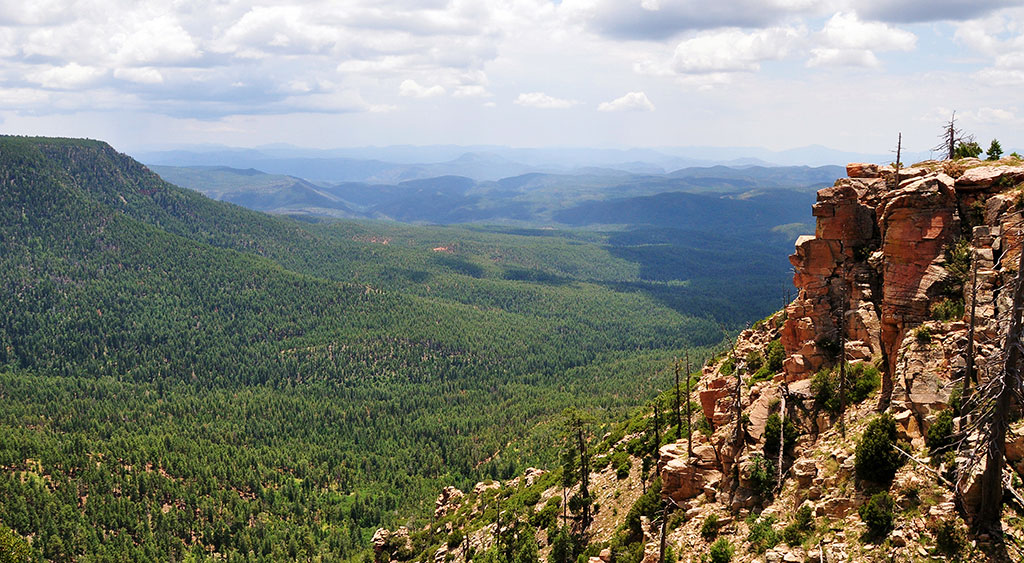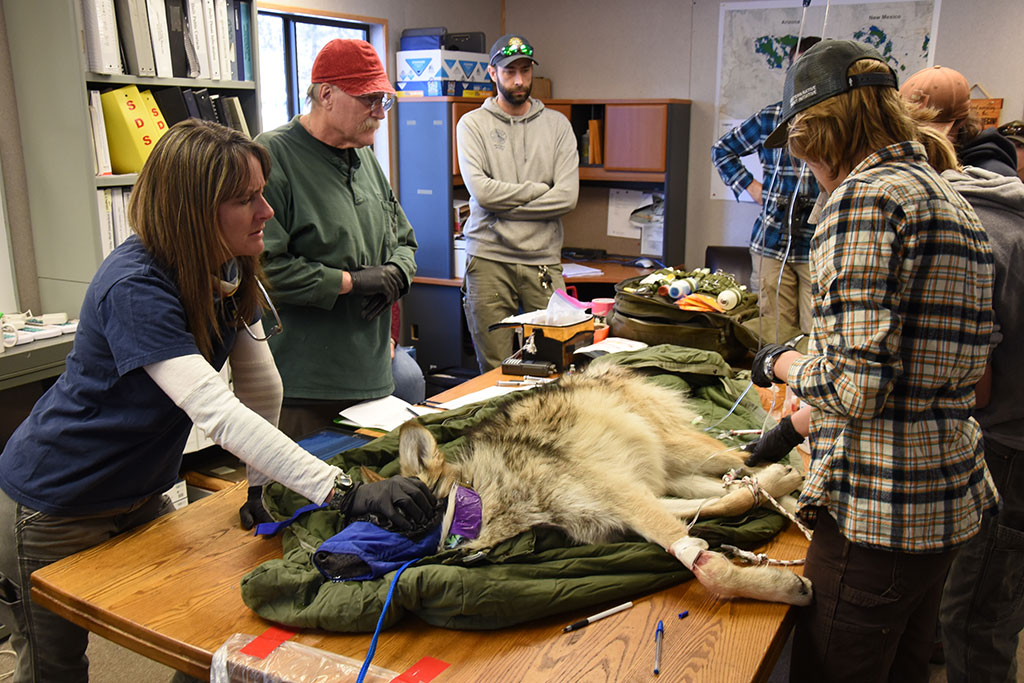It is rare to get a look at a Mexican wolf in the wild. But wolf advocate Jean Ossorio says it’s possible “with a little patience, plenty of time, and a bit of luck.” The retired schoolteacher has had more than 50 sightings over the last two decades.
 photo Apache-Sitgreaves National ForestsM1676 was one of four pups born in spring 2016 to the Bear Wallow pack that roams the east-central portion of the Apache-Sitgreaves National Forests in Arizona.
photo Apache-Sitgreaves National ForestsM1676 was one of four pups born in spring 2016 to the Bear Wallow pack that roams the east-central portion of the Apache-Sitgreaves National Forests in Arizona.
Since the spring of 1998, when the first wolves were released back into their native habitat and allowed to roam, hunt, and raise pups in a mountainous area that straddles the Arizona-New Mexico state line, Ossorio has spent 477 nights camping in the recovery area.
This year, she and her husband embarked on their annual winter trip the first week of January and pitched their tent north of the Bear Wallow Wilderness in the home range of a family of wolves named for the area. There was little snow on the ground at the time, and the coldest night was a relatively mild 21 degrees.
Over the course of three days, the Ossorios heard howls, saw tracks, and one morning spotted a young uncollared wolf that they thought was a male. For almost half an hour they watched him from a distance with binoculars and took photos as “he hunted and moseyed around a meadow.” Before he wandered out of sight into a stand of trees, he stopped and howled, but got no response. They suspected he was a juvenile from the Bear Wallow Pack.
A couple of weeks after the Ossorios’ camping trip, the Interagency Field Team in charge of Mexican wolf management captured the first wolf in the 2018 Mexican wolf population survey. It was a bright, cold January morning when a helicopter carrying the darted wolf lifted off from a clearing in the Apache-Sitgreaves National Forests. The flight crew, in radio contact with the waiting ground team about 25 miles away, provided details about the wolf: Bear Wallow Pack. Male. Uncollared.
Within a few minutes a young woman in a flight suit and helmet carried the limp, muzzled, and blindfolded yearling into the double-wide trailer at a US Forest Service compound near Alpine, Arizona. The group assembled around the conference table was ready.
After a wildlife biologist weighed the wolf in at 57 pounds, two team members placed him on an unzipped, green sleeping bag spread out on the table and loosely hobbled three of his feet. A volunteer monitored his temperature with a bright green rectal thermometer. Susan Dicks, a veterinarian with the US Fish and Wildlife Service (FWS), listened to his heart with a stethoscope.
“All these things we do here today – the fluids, the vaccinations, the blood draw – are all things we do to a pet animal in a pet hospital without drugs,” he said. “These are not painful things, but because this is a wild animal we’re more careful for human safety and for animal safety.”
Quietly, the team conversed while they bolted the radio collar, wrapped with brightly colored duct tape, around the wolf’s neck. Now identified by his studbook number, Male (M)1676 can be tracked along with his pack mates and other collared wolves.
It’s been 20 years since the first Mexican gray wolves were released in the US, and the small population is monitored by FWS with assistance from other federal, state, and tribal agencies. Each year they conduct the survey to get an official count and to radio-collar yearlings.
M1676 spent 30 minutes on the improvised exam table before being placed in a large animal crate to recover from the darting drug. He appeared to be healthy, maybe a little thin, but normal. According to Dicks, “These are wild animals working for their food.” Almost full grown, he had a heavy, grizzled, multicolored coat, long legs, and big paws, built to run for miles in all types of terrain and weather.
For wolf pups, 2016 was a good year. Fifty, including M1676, survived until the end of the year, bringing the total wild Mexican wolf population up to 113 in the United States. M1676 was part of the first litter of pups born to the Bear Wallow Pack – comprised of a four-year-old female (F1335) and her three-year-old mate (M1338) who had dispersed from a pack in New Mexico. The pair had established a territory in Arizona near the home range of F1335’s birth pack. Although the families of the two wolves were separated by a state line, they were closely related.
The genetic diversity of the wolves in the wild has dwindled even as their numbers have slowly increased. The public largely supports the reintroduction effort, but unyielding resistance from some ranchers and hunters has prevented what might lessen this genetic danger: the release of more adult wolves from captivity.
By the end of 2017, the Bear Wallow Pack included the two adults, M1676, and three pups born in the spring. They roam the east-central portion of the Apache-Sitgreaves National Forests in Arizona where their primary food source is elk. They have never had a reported interaction with the cows that sometimes graze in their territory.
The radio in the Forest Service trailer crackled midafternoon on the day of M1676’s capture, announcing that he was “up on all fours and alert.”
The crew trucked him back out to a spot near where he had been darted, for release. His first steps, captured on video, were halting, but within seconds he disappeared from the camera’s view on his way to find his pack. Ossorio watched the video of M1676’s release and thought he might be the same wolf she saw earlier in the month, but there was no way to know for sure.
M1676 turned two this spring and may disperse later this year. It will be nearly impossible for him to find a mate that is not a close relative. According to the FWS 2018 release proposal, “On average, individuals within the population are as related to one another as full siblings.” Even with that dire assessment there are no plans to release any adult wolves into the wild, only newborn pups from captivity that will be placed into existing packs.
The FWS published its survey results in late February – 114 Mexican wolves are living in the wild, an increase of only one wolf from last year. The number of pups, 26, was half that of the prior year.
 USFWSMembers of the Intreragency Field Team in charge of Mexican wolf management check M1676’s vitals and administer vaccines.
USFWSMembers of the Intreragency Field Team in charge of Mexican wolf management check M1676’s vitals and administer vaccines.
“Frustrating! [The] 2017 end-of-year numbers are out and they aren’t pretty!” was Ossorio’s response.
Though the overall increase was disappointing, Maggie Dwire, assistant Mexican wolf recovery coordinator with the FWS, says: “We have a higher percentage of sexually mature adults going into breeding season. What we hope to see is another bumper pup year.”
As of March, M1676’s family was still traveling together. Within weeks they may have a new litter of pups. The Bear Wallow Pack is a testament to how far Mexican wolf recovery has come in the last 20 years, but is also a symbol of the challenges that must be overcome to eliminate the threat of extinction.
We don’t have a paywall because, as a nonprofit publication, our mission is to inform, educate and inspire action to protect our living world. Which is why we rely on readers like you for support. If you believe in the work we do, please consider making a tax-deductible year-end donation to our Green Journalism Fund.
DonateGet four issues of the magazine at the discounted rate of $20.